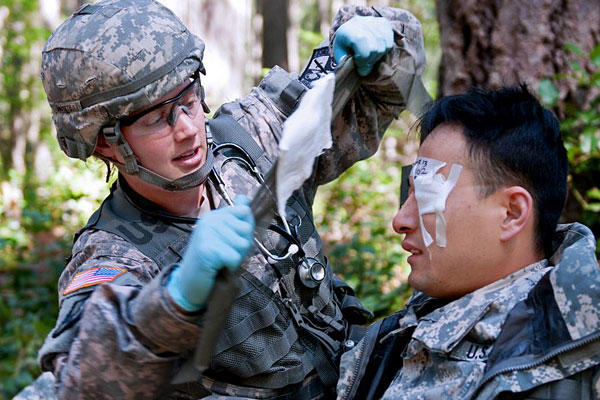Nearly two years after the services committed to including eye shields in the individual first aid kits of combat troops, the devices remain largely absent from the kits even though eye injuries continue to account for 10 to 15 percent of the war's wounded.
The metal shields, which create a protective vault over the wounded eye to guard against further damage, are carried by Army medics and Navy corpsmen. However, it's often a buddy -- another soldier -- who is first on the scene to provide care, said Col. Robert Mazzoli, an ophthalmologist and executive director of the Vision Center of Excellence at Walter Reed National Military Medical Center.
"If the immediate first aid is 'buddy aid,' [and] the shield is not at the point of injury at the time it is needed, that would be analogous to saying 'my buddy has a traumatic amputation but the tourniquets are with the medic and they are not here right now,' " Mazzoli said. " 'I have to wait until the medic gets here before I can put the tourniquet on.' "
Often, a soldier will apply a bandage over the wounded eye, inadvertently setting the stage for worse damage, he said.
"Unlike any other injury where pressure, direct pressure, is recommended in first aid … the eye is intolerant of that. It is unforgiving of that," he said. "You start putting pressure on an eye injury and very quickly the retina and the intraocular contents … [fluids] on the inside of the eye -- are squeezed out."
Absent an eye shield, he said, troops should use the ballistic eyewear issued to them as a vault cover for the eye, and wrap any bandages over that. Even a knee pad can work in a pinch so long as it is secured and does not touch the wounded eye, he said.
Not even soft gauze should be placed between the eye and whatever is shielding it, he said.
The Vision Center of Excellence, one of several Defense Department medical brain trusts established by Congress several years ago to spearhead DoD research into care and treatment of war injuries, began in 2010 pushing to have eye shields in every individual first aid kit, or IFAK.
Medics, corpsmen and other trained first responders understand the need and use of the shields; however, eye-injured troops were regularly being medevaced to in-country surgical units wearing bandages that covered and put direct pressure over the eye.
In many cases, the closest eye shields were at a base or location actually flown over by the helicopter on its way to the hospital, Mazzoli said.
The VCE began recommending the eye shields be standard in individual first aid kits, such as tourniquets are now. The recommendation was endorsed by the Committee on Tactical Combat Casualty Care, the tri-service group set up in 2001 to ensure combat care guidelines were always current.
The Defense Department said in January 2012 that the eye shields already were in every Air Force and Marine Corps IFAK, and that the Army would soon be adding them to its own kits.
But the services never have been consistent about including the shields, so some troops who sustain an eye injury in Afghanistan are returning from the field wearing a pressure bandage over the eye, according to Mazzoli.
The just-released report by the Department of Defense Recovering Warrior Task Force also noted the services' failure to adopt the VCE's recommendation. "Unfortunately, the VCE continues to struggle to get this practice implemented consistently across all the services," the report states.
Mazzoli does not know why the services have not followed through on the eye shields.
"That's an answer I cannot give," he said. "Those answers belong to Defense logistics. VCE's function is to advocate for changes, assist in changes [that benefit troops]. But in terms of actually implementing … we don't have that authority."


























